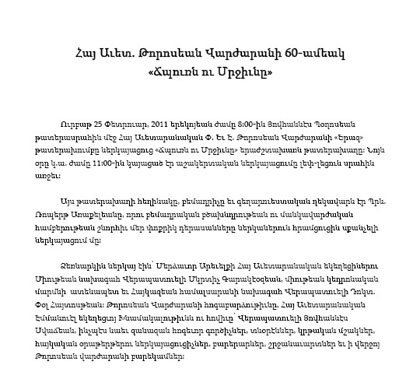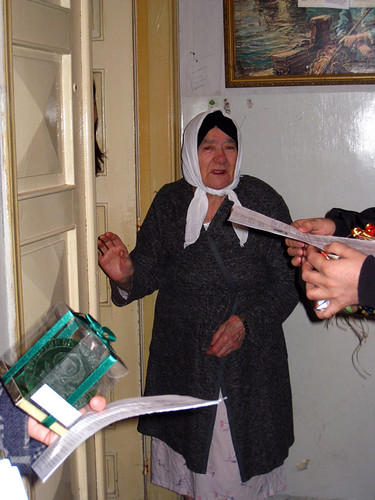Being a lover of history books, specially those related to the period after the 1915 Armenian Genocide and how the churches were relocated to Greece, Cyprus, Syria, Lebanon, I finished reading the latest book Vgayakroutyoun that was published by the Rev. Avakian's daughter, and authored by Rev. Avak Avakian himself.
The book is in Armenian, and it contains Rev. Avakian's memories that extends from his childhood years in Hasabeyli, in Turkey, till his elderly years passing through Greece, France, Syria, Lebanon, and Canada. Rev. Avakian's narrations, anecdotes, and stories are invigorating, inspiring, full of bravery and fearlessness.
I have never known Rev. Avakian, nor had heard about him, but his honesty and bravery took me by surprise, specially his outright condemnation of the attempts of the Armenian political parties of the time, in taking control of every top head of schools and organizations, by deeming them rather less Armenian. Also, his straightforward remarks about the disputes in the General Conventions of the Armenian Evangelical Churches are noticeable. He also accuses the members of the secret societies of his time, mentioning that even though they helped the church, yet despised its mission.
Raffi

Published by the Union of the Armenian Evang'l Churches in the Near East, 400 pp, pb, $30.00
Rev. Avak Avakian’s (1904-1983) memoires cover seven decades of journey,
which started in his birthplace of Hassabeily (Cilician Armenia) and ended in Sarnia (Ontario, Canada). After witnessing the Armenian Genocide and the
Kemalist purge in his homeland, he experienced the life of a refugee in Aleppo. He pursued his education in Tarsus, Beirut, Paris and Athens and served his Lord and his people as a pastor and a principal in Armenian schools and churches in Damascus, Beirut, Aleppo, Azez, Kessab, Zahle and Chtaura.
His memoires are of historical value since they document both eye-witnessed and personally experienced events and personalities. This is especially true when they narrate his personal experiences of the Armenian Genocide, life in Aleppo as a refugee, as a student at St. Paul’s College in Tarsus and at the Athen’s School of Religion. Overall, his memoires are
of special significance to the history of Armenian Evangelicals in the Middle East between the years 1930-1969.
Rev. Avakian retired in Sarnia, Canada, where he remained until his last days in touch with church life and devoting time to writing his memoires.
This book includes three appendices which were written, compiled and edited by Dr. Yervant H. Kassouny. The appendices are a biographical presentation of the personalities mentioned by Rev. Avakian in his memoires, the documents which support the events mentioned in the memoires and the words of condolences and sympathy testimonies expressed on the sad occasion of Rev. Avakian’s death in 1983.
AMAA
The book is in Armenian, and it contains Rev. Avakian's memories that extends from his childhood years in Hasabeyli, in Turkey, till his elderly years passing through Greece, France, Syria, Lebanon, and Canada. Rev. Avakian's narrations, anecdotes, and stories are invigorating, inspiring, full of bravery and fearlessness.
I have never known Rev. Avakian, nor had heard about him, but his honesty and bravery took me by surprise, specially his outright condemnation of the attempts of the Armenian political parties of the time, in taking control of every top head of schools and organizations, by deeming them rather less Armenian. Also, his straightforward remarks about the disputes in the General Conventions of the Armenian Evangelical Churches are noticeable. He also accuses the members of the secret societies of his time, mentioning that even though they helped the church, yet despised its mission.
Raffi

Published by the Union of the Armenian Evang'l Churches in the Near East, 400 pp, pb, $30.00
Rev. Avak Avakian’s (1904-1983) memoires cover seven decades of journey,
which started in his birthplace of Hassabeily (Cilician Armenia) and ended in Sarnia (Ontario, Canada). After witnessing the Armenian Genocide and the
Kemalist purge in his homeland, he experienced the life of a refugee in Aleppo. He pursued his education in Tarsus, Beirut, Paris and Athens and served his Lord and his people as a pastor and a principal in Armenian schools and churches in Damascus, Beirut, Aleppo, Azez, Kessab, Zahle and Chtaura.
His memoires are of historical value since they document both eye-witnessed and personally experienced events and personalities. This is especially true when they narrate his personal experiences of the Armenian Genocide, life in Aleppo as a refugee, as a student at St. Paul’s College in Tarsus and at the Athen’s School of Religion. Overall, his memoires are
of special significance to the history of Armenian Evangelicals in the Middle East between the years 1930-1969.
Rev. Avakian retired in Sarnia, Canada, where he remained until his last days in touch with church life and devoting time to writing his memoires.
This book includes three appendices which were written, compiled and edited by Dr. Yervant H. Kassouny. The appendices are a biographical presentation of the personalities mentioned by Rev. Avakian in his memoires, the documents which support the events mentioned in the memoires and the words of condolences and sympathy testimonies expressed on the sad occasion of Rev. Avakian’s death in 1983.
AMAA











































